Basil (Ocimum basilicum) is one of the easiest herbs to grow. All it needs is lots of sun, lots of water and lots of warmth. It should be a staple in every cook’s garden.
Basil is native to India and Thailand where it is a perennial. In areas colder than growing zone 10, it is grown as an annual. Basil loves hot humid weather so provide it with lots of moisture. Basil comes in many sizes, ranging from the 8 inch globe basils all the way up to the 4 foot Pesto Perpetuo cultivar. Even the leaves come in different sizes. The globe basils have tiny leaves while the lettuce leaf basils have enormous leaves.
You can purchase basil plants from any nursery, but they generally offer very few varieties. If you grow basil from seed, more varieties are available to you.
Growing basil from seed is easy. Start your seeds indoors 6 to 8 weeks before your last frost date. Plant the seeds ⅛” to ¼” deep. Planting depth is critical. If you plant your seeds too deeply or too shallowly, germination will be very poor or non-existent. It’s a good idea to always check your seed packet. Most of them tell you how deep to sow the seeds.
Once you have sown your seeds, gently press down on the soil. Don’t tamp it down hard. You don’t want to compact the soil, you just want to make sure that all of your seeds have good contact with the soil. This is important because seeds germinate when the soil reaches the correct temperature for them. Basil seeds germinate when the soil temperature is 70°F to 85°F. A heat mat under your flats is a good way to ensure that your soil stays at the correct temperature.
Keep your seeds moist. Not wet, moist. Seed germination in basils is very quick, averaging 6 to 12 days. If you are growing your seedlings in a soilless mix with no nutrients, you will need to fertilize them when they have two or three sets of leaves. Use 20-20-20 or 20-10-20 fertilizer.
When your basil is ready to be planted outside, don’t take them directly from inside your nice, warm, climate controlled house and put them directly into the garden with varying temperatures, wind and blazing sunlight. Not only will they go into shock, but plants, like us, get sunburned. You need to ˝harden off˝ your seedlings before planting them outside. This takes about 10 days. Put your seedlings outside during the day first for an hour or so, and then longer each day until they are outside all day. Don’t put them in direct sunlight at first. Dappled shade is best. Increase the amount of sunlight each day until your plants can tolerate full sun.
Once your seedlings are hardened off, it’s time to plant them in your garden. Be sure to use 2 to 3 inches of mulch to prevent weeds from growing and to hold moisture in the soil. Plant them in full sun and keep them well watered. If cool temperatures (40’s or 50’s) are predicted overnight, throw a sheet over your plants to protect them from the cold. Basil doesn’t like being chilled. Remove all flowers from your plants during the growing season. To keep your basil producing flavorful leaves, don’t allow them to bloom or go to seed.

Basil Dolce Fresca
Image courtesy of All-America Selections
In the fall, harvest all of the leaves when a frost is predicted. Frost may kill the plants, but the leaves can be frozen to provide you with fresh basil all winter.
No garden? No problem. Basil grows great in containers. Put your container in a sunny spot and water it every day. Containers dry out faster than soil in your yard.
Make sure that you have lots of room in your garden or a large container. Basil comes in seemingly endless varieties.
If you only have room for one type of basil, I always recommend Genovese basil, an heirloom variety. Basils are susceptible to fusarium wilt, a fungus that persists in the soil for years. Try the deceptively named Mozzarella basil which was bred to resist fusarium wilt. Pesto lovers should grow Superbo basil, specifically bred for pesto. It has more intense flavor than Genovese basil.
Large leaf basils, such as Mammoth Sweet basil, are good for sandwiches and can be used to wrap chopped meat and vegetables in Mediterranean and Korean dishes.

Bush Basil
The globe or bush basils with their tiny leaves, are great for borders in your garden. In the kitchen, they will save you prep time because the leaves don’t need to be chopped up.

Purple Ruffles Basil
Purple basils add color to salads. Used in flavored vinegars, they turn the vinegar a deep
red. Osmin Purple basil is the darkest of the purple basils. My favorite is Purple Ruffles basil with its ruffled leaves.
Want a basil with a different taste? Try lemon basil. Same great basil flavor, but with a hint of lemon. Mrs. Burns’ lemon basil is an heirloom variety from New Mexico. It has a more intense lemon flavor than standard lemon basils. A good alternative is Sweet Dani Lemon basil, an All-America Selections winner for 1998. Another good citrus flavor choice is Lime basil. As the name indicates, it has a hint of lime flavor.

Thai Basil
Asian cooks should never be without Thai basil with its attractive purple stems and anise flavor. A good option is Siam Queen Thai basil, another All America Selection from 1997. Hispanic cooks love cinnamon basil from Mexico. It has a cinnamon flavor and purple-red stems.
No matter which basil you choose to grow, you can look forward to a delicious harvest all summer long.


6 Comments on “Basil”
Pingback: Basil Dolce Fresca – 2015 AAS Winner - Advice From The Herb Lady
Pingback: The ___ ate my tarragon! - Advice From The Herb Lady
Pingback: Monday in the Greenhouse - Advice From The Herb Lady
Pingback: 2017 Seed List – Postcards From The Pumpkin Patch
I am growing a basil called BASIL Lettuce Leaf, has large crinkled leaves. Smell is amazing, seeds can be purchased from PARK SEED CO.
Lettuce leaf basils are bery popular because the large leaves yield a large harvest. There are many different kinds. My personal favorite is Napolitano basil. Seeds for most kinds of lettuce leaf basils can be purchased from all reputable seed companies, including Park Seed.